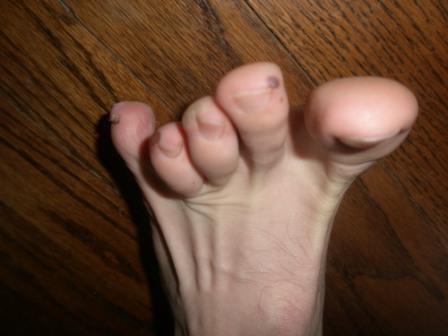
A couple of weeks before my sophmore cross-country season my father, brother, and I went hiking for three nights on the Appalachian trail. Being the over-confident 15 year old that I was, I wore tennis shoes instead of hiking boots on the trail. I had been backpacking plenty of times before in tennis shoes but this time I seemed to develop some serious blisters (not to be confused with serious running). One large blister in particular was on the bottom of my arch and kept growing larger and larger during the entire cross-country season. I learned a lot about blisters and even visited a podiatrist. Just because it requires less schooling than other doctors, a podiatrist is a doctor. Some people just really love feet. It’s better than being a proctologist because you love that part of the body.
Blisters are caused by friction, heat, dirt (which causes friction), and moisture on your feet. You don’t want to create any friction, so make sure you break in that new pair of running shoes before going on a 20 mile run. Although it is tough to tell by merely trying on a pair of shoes, try to make sure your shoe fits properly. Many runners use small strips of duct tape (instead of band-aids) to cover hot spots on the areas they know are blister prone. Duct tape stays in place well and the shiny back slides on your socks and feet, I recommend it. Another technique to reduce friction is using petroleum jelly, but I’m sure you already knew petroleum jelly’s physical attributes. You probably also already know that this technique tends to become very messy on long runs. I’m sorry. I too hate it when people tell me things I already know. You also want to keep your feet dry. Make sure you always have fresh (meaning not wet) pair of socks on. If you’re high tech, you can also wear moisture-wicking socks made from synthetic blends. Or if you are old school, simply apply foot powder before your run. If you are really old school, then just throw some flour on your feet.
If you already have a blister, I’m sorry for you, they suck but there are things you can do for them. If the blister doesn’t make walking painful, then put duct tape over it when running; otherwise leave it alone and let it heal by itself. The body has its own, amazing healing powers. Very magical. If it does hurt then you need to drain it. When there is excessive friction the body produces a fluid underneath the skin. You know that fluid isn’t necessary, so release it. First sterilize a needle and make four insertions at each corner of the base of the blister. Then press down on your skin and allow for all of the fluid to drain out. The reason for the four insertions is that you want to make sure you get all of the fluid out of every pocket of the blister. Do not tear off the skin. Natural skin the best protection against friction on your foot. After you pop the blister, allow it to heal in the air as much as possible. Fluid dries. If your blister is leaking yellow fluid or has red lines around it then it may be infected. Consult a doctor…a podiatrist type.
There are other techniques using moleskin and 2nd skin but those are for when your blister goes from bad to worse. The best thing to do is catch the blister early. You could go a whole cross-country season competing on the same blistered foot; but still do awesome. Running’s 90% mental anyways. Blister prevention will just help you on the other 10%.
Tags: blisters
[…] a loose fit with a tighter fit in the heel so your foot doesn’t come out of the shoe. I got blisters from the heal the first time I ran in the Vivobarefoot Evos but I blister easily, just make sure […]
Using Tape Relief (http://www.taperelief.com/) is a great way to protect against heat and mositure. It goes on like a lotion and creates a barrier over the skin. It works great for me!